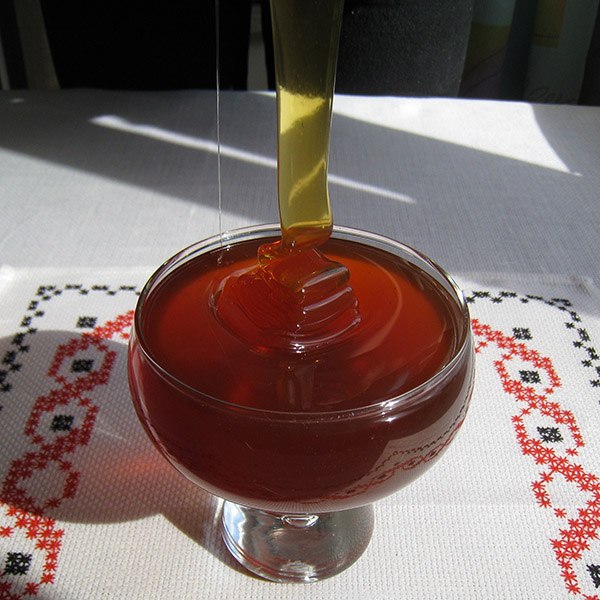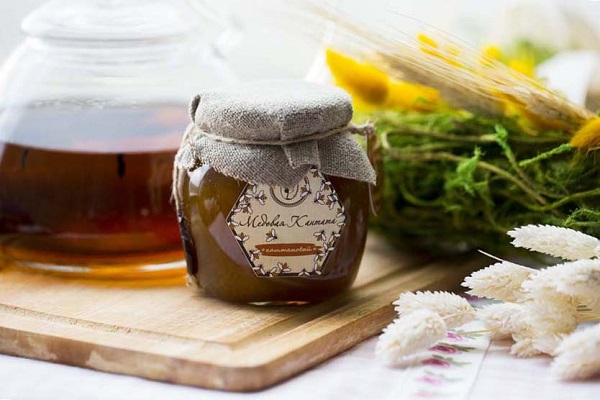Chestnut honey in its pure form is rare. This is due to the territory of the spread of honey. But if you buy a non-counterfeit product, you are lucky, because this variety has an antibacterial and anti-inflammatory effect.
Some beekeepers and lovers of feasting refer it to low-grade honey. This is due to the presence of bitterness in taste. In this article we will talk about the beneficial properties and contraindications for the use of chestnut honey. And also learn about its therapeutic action.
Table of contents
Taste and color
The color of chestnut honey depends on where the plant grows, in what weather nectar was collected (weather and climatic conditions), what type of chestnut is used as a honey plant. With cloudy weather, it is more concentrated. In normal weather, its color is reminiscent of chocolate. It is consistency by consistency, it is impossible to spill it.
Several seasons may not crystallize. This indicator is used for medicinal purposes and cosmetology, since candied honey loses its elasticity, and after heating it, it also has beneficial properties.
To determine the real honey or not, will help the color and taste.
Ingredients: vitamins and minerals
For a long time, a large amount of fructose in its composition helps to remain a liquid, viscous product. It is more than glucose, so after consulting with a doctor this variety can be used for diabetics.

A large number of minerals sodium, phosphorus, iron, iodine; trace elements: zinc, fluorine, manganese,copper; amino acids and natural biogenic stimulants make this natural product valuable to health. It contains ascorbic acid (vitamin C), vitamins of group B, vitamin K and E, and others. Very nutritious. 100 g of the product contains 284 kilocalories. There are practically no proteins and fats in its composition.
Useful properties of chestnut honey
The benefits of this product is invaluable. This variety is an excellent antiseptic. With it, wounds heal, even in patients with diabetes. It is also useful for such people in food. After consulting with your doctor, you can take it as food, since more than 90% of the honey is absorbed directly into the blood due to the increased fructose content.
In the autumn-winter and winter-spring period, thanks to its three-time use in food during the day, one tablespoon, the body's immunity increases. An eaten on an empty stomach spoon of chestnut honey in a chime and in the evening after drinking a glass of water provides an enveloping of the oral mucosa, and after getting into the stomach - and the intestinal walls.
This protects the body from the action of harmful bacteria, tightens existing wounds and sores. It is used in cosmetology, cooking, traditional and alternative medicine.
You may be interested in the following articles on the topic of honey:
- How to cook and Trepang honey treatment?
- how make a bee trap at home with your own hands?
- The use of propolis tincture for medicinal purposes.
- Secrets wax moth tincture treatment.
Contraindications and harm
It is not recommended for people who do not tolerate honey, or who are allergic to chestnuts. In this case, you can harm the body.It is recommended to apply a little product on the back of the skin of the cyst of its back side before using it, wait a few minutes.
If there is no negative reaction, use this variety as a remedy.
About honey plant
Honey beetle of this variety is chestnut, which grows in the Caucasus, in the Crimea, in the south of France and Italy. It is the French who supply this product to the stores in larger quantities.
Blooms profusely in May and early June for two weeks. Therefore, if the beekeepers want the bee to get a bribe from this honey plant, you need not to miss the deadlines. The weather during this period is favorable for bees, because there is no heat yet.
The main thing is that there is no frequent rain. The plant gives a lot of nectar and pollen. Therefore, honey is obtained very much. The abundance of flowering compensates for a short period of the possibility of collecting nectar for bees.

Storage conditions
It is better to store the product at a temperature not higher than 19 degrees. This applies to the period when the honey after pumping is in a liquid, non-candied state. In such a consistency, it is stored for up to two years.
After that crystallizes. Storage temperature is reduced to 5 degrees Celsius. You should not lower it below zero or warm the honey after crystallization in order to avoid the loss of its healing and nutritional properties.
So that honey does not absorb excess moisture, if it is not stored in an airtight container, we maintain air humidity at the level of 59-61%. It is preferable to use glassware for long-term storage. Plastic is suitable for transportation.
Medicinal properties
Chestnut honey is used as a prophylactic agent for the gastrointestinal tract. Thanks to its properties, the cardiovascular system is strengthened. It is indispensable for respiratory diseases. Helps relieve stress, soothes, so it is taken at bedtime. Beneficial effects of this product also on the work of the kidneys and liver, fights against eye diseases, including conjunctivitis.
Chestnut honey - an amateur. Sweeteners will be disappointed because of the inherent bitterness of this sort in taste. But no one will deny its beneficial and healing properties. The main thing to get a natural product, not a fake. Then you will appreciate it.

This exotic honey in our area was brought by a daughter from France especially for her grandmother, she is diabetic with us, so our daughters advised her to buy chestnut honey as a gift. It tastes a little bitter, but diabetics do not need much.We are stirring a teaspoon in a glass of water in the morning and letting Grandma drink this healthy drink - it’s good for your health, and Granny will have a sweet tooth.